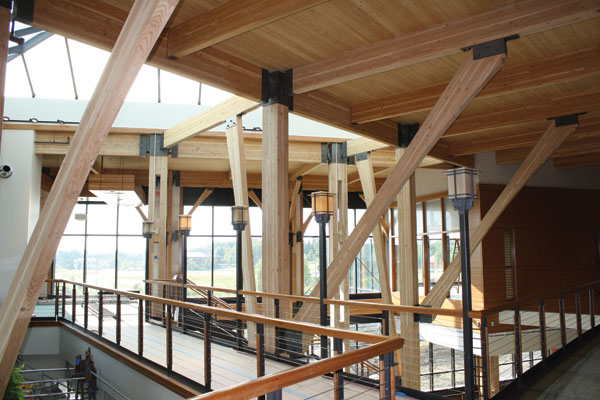Modern Building Codes: Keeping Pace with the Wood Revolution
Mass timber. Since the invention of modern day plywood in the early 1900s, a succession of new engineered wood products have offered increasing strength and stability, expanding the options for (among other things) taller walls, taller buildings and longer unsupported wood spans. In the latest development, mass timber products such as CLT, glulam and laminated veneer lumber are inciting much discussion around the safety, feasibility and economics of constructing high-rise wood buildings.
Common in Europe but relatively new to North America, CLT typically consists of three, five or seven layers of solid dimension lumber, kiln-dried and layered perpendicular to one another and then glued to create full-depth solid wood wall and floor panels up to 12 feet by 60 feet. This cross lamination provides exceptional strength, stability and rigidity, allowing CLT to be used as a low-carbon alternative to concrete and steel in many applications. Benefits also include quick installation, minimal on-site waste, light weight and (as a result) reduced foundation requirements, thermal performance and design versatility.
Internationally, examples of mass timber buildings include eight-story CLT buildings in Europe, a 10-story CLT building in Australia and a 14-story building in Norway (under construction) comprised primarily of load-carrying glulam trusses and prefabricated building modules made from traditional timber framing. North American examples include (among others) a two-story CLT elementary school in West Virginia, a six-story CLT structure in Quebec, a five-story heavy timber/CLT hybrid building at the University of British Columbia, and an eight-level heavy timber/CLT hybrid (six stories plus a penthouse and mezzanine), also in British Columbia.
In the U.S., the 2015 IBC includes CLT of a certain thickness within Type IV construction. Fire-resistance testing has confirmed that CLT, like heavy timber, chars at a rate that is slow and predictable, maintaining its strength and giving occupants more time to leave the building.13 In May 2012, APA published ANSI/APA PRG 320-2011 Standard for Performance-Rated Cross-Laminated Timber, an American National Standard that provides requirements and test methods for qualification and quality assurance of CLT. CLT products manufactured to the standard have been recognized as code-compliant in the 2015 IBC.
Green Building Codes, Standards and Rating Systems
In addition to requirements designed to ensure safety and structural performance, there is a growing number of codes, standards and rating systems that seek to minimize a building's environmental impact.
The most recent example is the International Green Construction Code (IgCC), released in 2012. Adopted by eight jurisdictions so far, it is the latest phase in an evolution that's included two American National Standards (covering residential and non-residential construction), the California Green Building Standards Code (CALGreen) and ASHRAE 189.1, a code-intended commercial green building standard published by the American Society of Heating, Refrigerating, and Air-Conditioning Engineers (ASHRAE) in cooperation with the Illuminating Engineering Society of North America (IES) and U.S. Green Building Council.
The IgCC covers subject areas typically found in any green building effort, including site, materials, energy, water and indoor environment. Primarily a voluntary code that jurisdictions have adopted to provide guidance regarding public or publicly funded buildings,14 it includes “mandatory” provisions within all subject areas as well as recommended provisions and electives. It is potentially applicable to almost every commercial building project, including additions and repairs. In terms of material use, the IgCC's key mandatory requirement is that at least 55 percent of materials (based on mass, volume or cost) be used, recycled, bio-based and/or indigenous in any combination. However, this rule need not be met when a whole building life cycle assessment (LCA) is performed.15
LCA is a scientific approach to evaluation that considers the impact of materials over their entire life cycle, from extraction or harvest through manufacturing, transportation, installation, use, maintenance and disposal or recycling. When integrated into green building codes, standards and rating systems, LCA encourages design professionals to compare different building designs based on their true environmental impacts and to make informed choices about the materials they use. It replaces the prescriptive approach to material selection that's been common until now, which assumes that certain prescribed practices—such specifying products with recycled content—are better for the environment regardless of the product's manufacturing process or disposal. LCA studies consistently show that wood is better for the environment than steel or concrete in terms of embodied energy, air and water pollution, and greenhouse gas emissions.16
In the U.S., LCA is included in the Green Globes rating system and the American National Standard based on Green Globes, ANSI/GBI 01-2010: Green Building Assessment Protocol for Commercial Buildings, as well as the ICC 700 National Green Building Standard. It is part of both CALGreen and ASHRAE 189.1, and optional LCA credits related to LCA were recently added to the Leadership in Energy and Environmental Design (LEED) rating system (v.4). Although LCA isn't mandatory in the IgCC, elimination of the “55 percent requirement” is a powerful incentive for its use.
Wood: The Sensible Revolution
Today's building codes recognize wood's safety and structural performance capabilities and allow its use in a wide range of building applications, from the light-duty repetitive framing common in small structures to the larger and heavier framing systems used to build mid-rise/ multi-story buildings, schools and arenas. This hasn't been lost on design professionals seeking to have it all—cost effectiveness, functionality, design flexibility, beauty and environmental performance—who, through their collective projects, are leading a revolution toward the greater use of wood in non-residential and multi-family buildings.
Endnotes
- 1. http://www.woodworks.org/why-wood/
- 2. http://www.woodworks.org/why-wood/carbon-footprint/carbon-footprint-resources/
- 3. The American Wood Council offers a number of publications related to the fire design of wood buildings for code acceptance: http://www.awc.org/codes/dcaindex.html
- 4. Design of Fire-Resistive Exposed Wood Members, American Wood Council, http://www.awc.org/codes/dcaindex.html
- 5. ANSI/AF&PA SDPWS-2008 – Special Design Provisions for Wind and Seismic Standard with Commentary, American Wood Council; Design Concepts for Building in High Wind and Seismic Zones, APA
- 6. The January 17, 1994 Northridge, CA Earthquake – An EQE Summary Report, March 1994, http://www.lafire.com/famous_fires/1994-0117_NorthridgeEarthquake/quake/00_EQE_contents.htm
- 7. Seismic Safety Inventory of California Public Schools, California Department of Government Services, 2002, www.documents.dgs.ca.gov/dsa/pubs/FinalAB300Report.pdf
- 8. ANSI/AF&PA SDPWS-2008– Special Design Provisions for Wind and Seismic standard with Commentary, American Wood Council; Design Concepts for Building in High Wind and Seismic Zones, APA
- 9. Acoustical Consideration for Mixed-Use Wood-Frame Buildings, U.S. WoodWorks, 2014
- 10. Fire Resistance and Sound Transmission in Wood-Frame Residential Buildings, Canadian Wood Council
- 11. Wood and Human Health, Issue 1, FPInnovations, 2013
- 12. Wood as a Restorative Material in Healthcare Environments, FPInnovations, 2015
- 13. American Wood Council, www.awc.org/NewsReleases/2012/newsreleases2012.php#clt
- 14. The City of Baltimore is the only jurisdiction in which the IgCC is mandatory for all building construction.
- 15. More information on the International Green Construction Code is available from Dovetail Partners, Inc., www.dovetailinc.org.
- 16. Life Cycle Environmental Performance of Renewable Building Materials in the Context of Building Construction, Consortium for Research on Renewable Industrial Materials, Phase I 2005, Phase II 2010, http://www.corrim.org/pubs/reports.asp; A Synthesis of Research on Wood Products and Greenhouse Gas Impacts, Sarthre, R. and J. O'Connor, 2010, FPInnovations, http://woodworks.org/wp-content/uploads/FPI-Greenhouse-Gas.pdf; Wooden building products in comparative LCA: A literature review, Werner, F. and Richter, K., 2007, International Journal of Life Cycle Assessment, 12(7): 470-479
| The reThink Wood initiative is a coalition of interests representing North America’s wood products industry and related stakeholders. The coalition shares a passion for wood products and the forests they come from. Innovative new technologies and building systems have enabled longer wood spans, taller walls, and higher buildings, and continue to expand the possibilities for wood use in construction. www.rethinkwood.com | |










